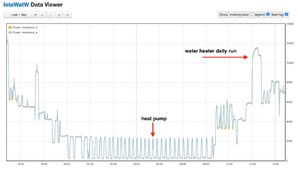If the resistance of a circuit is fixed, then you can't run lower voltage and get higher current. If the voltage is reduced then so will be the current.
This is exactly my point.
to have 3x panels in series you will have x amount of voltage, lets say 120 volts @ 10 amps.
putting the 3x panels in series, you would have 1/3 of voltage on hand thats 40 volts dc @ 30 amps.
the element resistance is constant "lets keep it for discussion"
so even if you have the amps, you do not have the voltage to push the amps through the resistance.
i will also argue, that any heating element will only use wht is needed from it.
so at 30 amps, not all amps will go through the resistor, you only get 25 amps to run trough the system at 40 volts dc.
my experience with 12 volt soldering irons shows exactly this.
if volts are higher, amps is also higher with resistors and heat is generated much more quicker.
if a lower voltage battery is fitted with unlimited amps, the element still only heats up to a certain degree and nothing more, even if more amps can be pushed through the system. the element will only use the amps it wants.
this is where ohms law might be confusing.
p=vxi
=40 volts dc x 25 amps, "heating element only using amps it wants to use
= thats a 1000 watts.
but p= vxi
= 40 volts dc x 30 amps avaiable. "heating element being forced to use the amps available
=1200 watts
in any case, i have been doing some testing, but ended up in hospital due to kidney stones.
my array so far was 4x 550 canadian solar panels all in series, which gave about 150 volts average amps was around 10 but could have gone up to 13 amps at times, maximum panel amps.
the array did manage to heat up a bucket of water within a period of time.
so then i fitted a 5th panel in series.
the voltage is now around 210 volts dc.
but my amp meter is not working, so i cannot see the amps running through the 2000 watt heating element.
the water in the jug started heating up faster and the system would also shut down as temp was reached.
so that was cool to see it work lekker.
i then obtained a plastic drum, which can take around 200 galons of water. it has some holes but i did plug some, so water loss is present.
the heating element is running ok. since early morning it will run and slowly build temp up to 62 degrees.
by then, the solar panels do not have direct sun light as the panels are facing east.
this drum does not have any insulation to prevent heat loss. in a geyser it should build up much quicker.
in any case, i am upgrading to 6x solar panels all in series.
this should push the voltage to around 250 volts dc with a maximum amp of 13.
but im running on normal operating test conditions which does make more sense and to use a 10 amp system.
lets see, how it goes.
i might even re fit 3x panels on the west side, and 3x on the east side, so a total of 6x solar panels in series
a note to consider.
voltage will be around 40 volts dc on each panel, multiply that with 6 you will get 240 volts dc, just what you need, but current might be way off if some are facing east and west.
getting the right panel in the sun, with 10 amps current will be enough to heat it all up.
but lets see where the experiment goes. as it has been working quite well.
i will deal with overcast days later.





